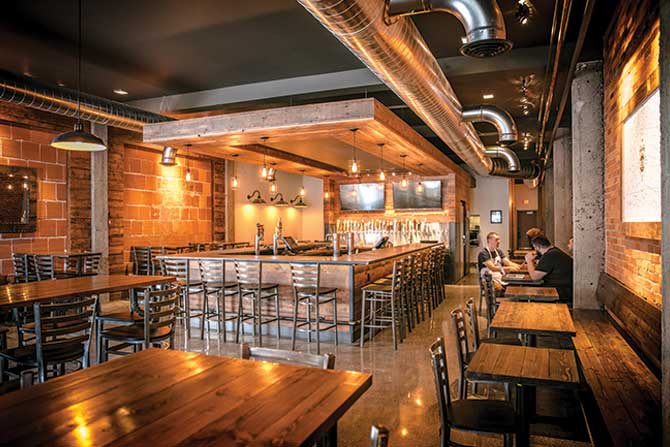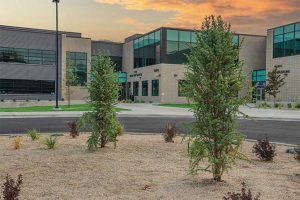By AIA Idaho
Located on the newly revitalized Main Street, this project is a centrally located gastropub within the Moscow community. The taphouse sought a refined yet rustic design that would honor the building’s past, located in the historic O’Connor Building built in 1953 and listed on the National Historic Register. Offering 25 rotating regional craft beers, local ciders and 10 wine variations on tap, it imbibes the character of the surrounding wheat-filled farmland of the Palouse hills. The project’s main function is a brewpub, and the U-shaped bar was engineered within this narrow space to face toward Main Street to ensure that passersby could see the large tap display within.
Retaining as much of the building’s existing structure and character as possible dictated the design direction. Most of the monies budgeted for the build-out were consumed by the kitchen equipment costs and the upgraded roof structure needed to support the rooftop units, making it imperative to use much of the preexisting space’s materials for the sake of cost savings.
The existing concrete storefront is wrapped with rough-sawn cedar rain-screen siding in warm tones. Fourteen linear feet of operable storefront glazing opens up onto the Main Street thoroughfare. The original interior brick and terra cotta tile walls around the restaurant’s perimeter are exposed and sandblasted to restore their beauty.
Concrete structural columns and bare steel joists are exposed, accented by rough-sawn recycled wood cladding salvaged from local dismantled barns. Original concrete floors are cleaned and polished for an updated appearance. The U-shaped bar is clad in locally salvaged wood and illuminated by Edison lighting.
The bar top was made of poured and polished concrete with bare steel edging and details. Every facet of the design had to be carefully coordinated, as the design’s technical aspects required the use of every ¼” of free space available.
These existing elements were accented by abundant reclaimed wood throughout the space, as seen in the soffit above, the main-bar cladding, the perimeter wall accents, and the restaurant’s seating elements. As with the locally sourced fare and drinks, the wood cladding used in much of the space was sourced from dilapidated barns in the area and given new life.
The restaurant’s rustic, reclaimed nature offers its customers a singular Palouse experience in conjunction with the locally sourced libations and fare. This intent is expressed in the design, giving patrons an equally unique experience, “tapping into” and incorporating the natural materials of the Palouse’s gently decaying farmhouses with a modern flair.











